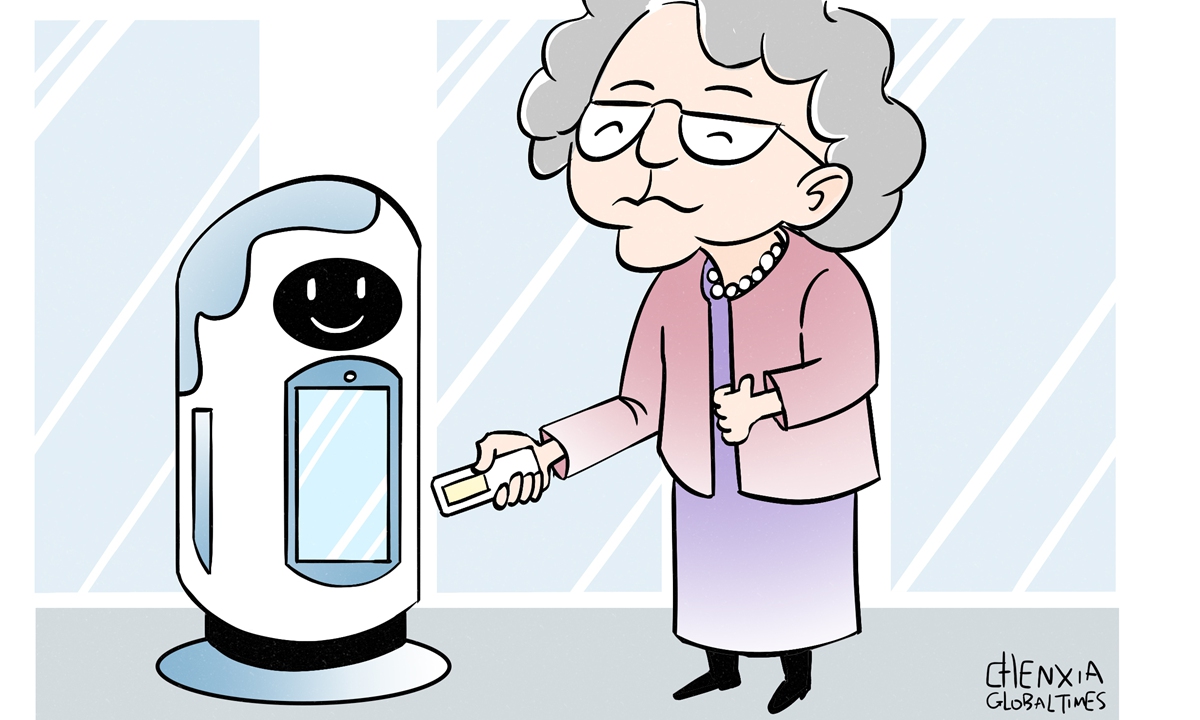
Illustration:Chen Xia/GT
Nowadays, aging and declining birth rates characterize China's population development. The population aged 60 and above surpassed 280 million by the end of 2022, accounting for 19.8 percent of the total, and it is predicted this will grow to over one-third by 2050.
As the elderly population increases and the demand for elderly care services expands, the size of families is shrinking, which has weakened the elderly care function of traditional families. Therefore, the responsibility for elderly care has to transfer from families to society.
Currently, pension funds are insufficient to afford socialized elderly care services in the long term. Social capabilities are poor in the infrastructure, standardized processes and monitoring mechanisms.
The gap is evident under the urban-rural dual structure in China. Public services and market development in rural areas need to catch up.
Additionally, factors like high labor intensity and relatively low-income lead to a need for more human resources, especially high-end talents. In this context, the traditional elderly care service industry finds it difficult to meet the demands of people of different consumption levels and from various regions.
With the advent of the digital age, empowering public services with accuracy, efficiency, and intelligence through information technology and data systems has become a new direction in urban governance.
Intelligent elderly care has emerged as a structural reform of traditional models, which introduces digital technology, updates old concepts, and optimizes services. It aims to improve service capabilities and experience by building a people-centered, demand-oriented, and system-integrated model featuring digitalization, intelligence, and precision.
In recent years, China has vigorously promoted the practice of intelligent elderly care, which can be summarized into three types in terms of scenarios: First, we have intelligent devices. These smart devices provide comprehensive protection for all periods and places in a flexible combination, such as a human behavior detection device installed in the bathroom, a smart health monitor installed at the bedside, and an emergency button that can be used to call for help.
Second comes a WeChat official account or application that reaches the "last mile" of the community by recruiting catering, medical institutions, supermarkets, and household management services to take care of nearby residents.
Third, the industry has intelligent elderly care platforms based on big data that integrate family, community, institution, and residential functions.
However, there is still ample room for our aging industry development to match various demands. We have the largest elderly population in the world, and the potential demand is enormous. The China Research Center for Ageing Sciences predicts that the possible volume of the aging industry will take up one-fifth of GDP by 2030 and one-third by 2050.
Especially when over 400 million "60s" and "70s," those who were born in 1960s and 70s, enjoy higher education levels and pursue higher elderly care services enter into old age, they will bring new prospects to the aging industry. Overall, their consumption demand and long-term arrangements for old age will profoundly impact the aging industry's development.
Accordingly, we should pay due attention to their characteristics and changes in skills, consumption capacity, and hierarchy of needs.
The Report on the Development of China's Aging Industry (2021-2022), released by the China Research Center for Ageing Sciences in 2023, shows the current situation and trends from 2021 to 2035. For example, new demand for services like health management, chronic disease treatment, rehabilitation devices, home renovation services, and financial products for the elderly will increase.
In the long run, from 2036 to 2050, as the "70s" and "80s" generations usher in their old age, demand in the aging industry will undergo more significant changes in consumption patterns, content, and levels.
Online shopping is more common, and spiritual pursuits like lifelong learning will likely be a more substantial part of life. For another, intelligent elderly care and other technology-assisted products will prevail. In addition, as services further expand, the demand for sports, tourism, culture, education, and legal services tends to increase significantly.
It is expected that over 20 million people will become seniors annually in the next decade.
Their needs diversify as they enjoy advanced education, a sound economic foundation, and access to various information channels, which will have a prominent impact on the transformation of China's supply and demand structure.
On the one hand, the demand for lifecycle health management is constantly growing. On the other hand, the existing supply system needs to provide more products and services. Thus, the aging economy is rich in enormous potential.
In January, the General Office of the State Council has released a new guideline that aims at improving the well being of elderly in China as well as developing the "silver economy."
The newly released guideline emphasized setting standards for the current industry when it comes to providing smart assistant services to elderly. Several sectors such as smart restaurants for elderly people, smart nursing homes were all included in the industry.
The guideline is the first policy document issued in China to encourage the "silver economy."
The author is a faculty member with the School of Applied Economics, Renmin University of China.